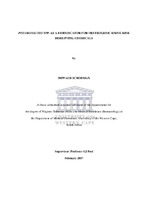| dc.contributor.advisor | Pool, Edmund J. | |
| dc.contributor.author | Schoeman, Dewald | |
| dc.date.accessioned | 2018-07-30T12:42:06Z | |
| dc.date.available | 2018-07-30T12:42:06Z | |
| dc.date.issued | 2017 | |
| dc.identifier.uri | http://hdl.handle.net/11394/6125 | |
| dc.description | Magister Scientiae - MSc (Medical BioSciences) | |
| dc.description.abstract | Environmental pollutants, such as endocrine disrupting chemicals (EDCs), are a health concern
as they can adversely affect animal health by interfering with the normal function of hormones.
Oestrogenic EDCs can cause adverse developmental and reproductive effects by mimicking or
inhibiting endogenous oestrogens. However, these effects are difficult to detect as they often
only manifest long after the initial exposure. Vitellogenin (VTG) is the precursor to the major
yolk protein vitellin (Vn) and is produced by egg laying females in response to oestrogens. The
VTG gene is also present in males, but silent. Thus, the presence of VTG and Vn in animals,
as well as the synthesis thereof in response to oestrogens, can serve a dual purpose in
biomonitoring experiments. These proteins can be monitored over a period of time to establish
the reproductive cycle of an organism and can also serve as a biomarker for oestrogenic
pollutants. | |
| dc.language.iso | en | |
| dc.publisher | University of the Western Cape | |
| dc.title | Potamonautes spp. As a bioindicator for oestrogenic endocrine disrupting chemicals | |
| dc.rights.holder | University of the Western Cape | |

